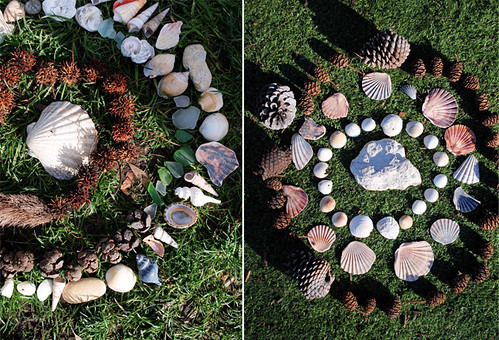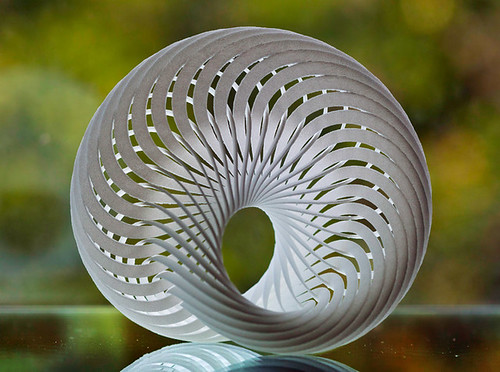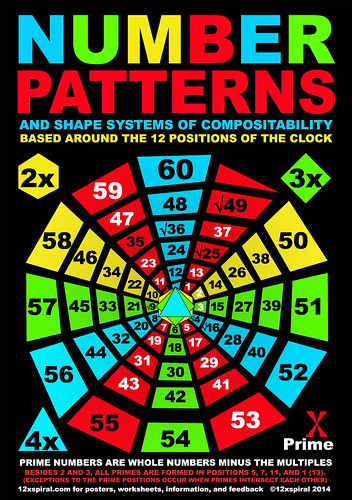Summer math and circle leaders incubator: Newsletter July 16, 2014
Subscribe and read archives
Pinterest | Twitter | Facebook | Google+
Hi, I am Moby Snoodles, and this is news about Natural Math.
Send me your questions, comments, and stories of math adventures at moby@moebiusnoodles.com

In this newsletter:
- Summer math: grind or adventure?
- Volunteer or business opportunities for you
- Will 3D printers change the world… of mathematics?
- Quick bits: 12x spiral, Playing With Math in Spanish, shapes out of shapes, jobs for kids
Summer Math – Grind or Adventure?
What does your child’s summer math time look like? Perhaps it is filled with worksheets and arithmetic drills similar to what they get to do the rest of the year. If that’s the case, it is time to get outside, and try mathematics that is playful, adventurous, creative, and lively.

Instead of giving your kid a beach-themed worksheet for counting shells or adding fish, do some beach combing first and then create mandalas with the found objects. Along the way your child can explore rotational symmetry, patterns, and even integration.
Going to a park instead? Pick up a few sticks and have a game of “how many triangles can you build with these sticks?” or challenge your child to create a circle out of the straight sticks.

Use pool noodles to build giant geometric solids. Go berry picking and invite kids to create complex shapes out of simple blueberries – for a tasty introduction to integration. Having a picnic? Pack some tangramwiches.
If you are worried that your child will experience a “brain drain” without the worksheets and won’t do well in math come the new school year, keep in mind that arithmetic is just a tiny part of mathematics. Treat summer break as a chance to develop your child’s mathematical mindset, not just the ability to manipulate numbers.
1001 circles: Opportunities for leaders
We often get calls for help from people who want their kids to be in a math circle, but can’t find one nearby. We hear you! This lack of circles means a lot of opportunities for growth and leadership – for teens, parents, grandparents, teachers, and anyone who loves math and cares about kids. If you are already leading a math circle, tell us about your experience. If not, have you ever thought of leading math circles?
This Fall, we are starting a training program for new math circle leaders. It will focus not only on content, but also on time planning, building healthy communities, money, logistics, psychology of learning, and any other support that leaders of math circles need to succeed. We will work with this group of leaders very closely to determine and address their needs. As a result, members of the program will prepare and run their first math circles, either as volunteers, or as a paid service. Unlike our open online courses, this program will be for a small group of people, because of the high amount of individual interaction with each participant.

Is this a good fit for you? It is if you are:
- A parent or grandparent who puts together playgroups, clubs, teams, or homeschool co-ops, and develops experience organizing groups for their kids
- A teen who organizes teams and clubs for yourself, or works as a tutor or camp counselor
- A tutor who is looking for better math content
- A math enthusiast who wants to try your designs and inventions with kids
- A teacher who wants to have more teaching freedom
- A mathematics, science, and technology professional who wants to do more teaching
If you want to participate, let me know by email at moby@moebiusnoodles.com
3D Printers for Math
Finally, 3D printers are becoming truly mainstream as Home Depot, the world’s largest home-improvement chain, starts selling them in some of their stores. Okay, only twelve stores, but it’s a good start. In a few years, having a 3D printer at home will be just as ordinary as having a regular printer is now. Which makes me wonder about math education, of course.
Printables of all sorts, including thousands of dull math worksheets, were made possible by cheap and ubiquitous paper printers and copiers. Will something similar happen with 3D printing? Will our kids end up having to work through some version of 3D math worksheets? Hopefully not! What math will you and your kids print when you get a 3D printer?

Meta-Mobius by joabaldwin
Blogs and networks: quick bits

Children are weird, like little space aliens, but they are better at some tasks than adults. They break all records on originality, provide deep insights, and rock divergent thinking tests. Want to imagine a world where children’s strangeness is recognized and used in professional settings? Check out our new collection, Jobs for Kids.
Our crowdfunding campaign for the book Playing With Math: Stories from Math Circles, Homeschoolers, and Passionate Teachers has reached its main goal. Big thanks to all who contributed! The first stretch goal is Spanish translation. We have 3 days left – will we make that goal? Help us reach Spanish-speaking people: tell your friends and colleagues about the campaign.

From squash that looks like a duck to 3D modeling, making shapes out of shapes is a traditional bridge into mathematics. Check out this collection of geometry to calculus activities for toddlers, kids, and adults.
1001 Circles is a series of stories that show what a math circle might be like, from the point of view of circle leaders. Last week, our guest was Joey Grether, whose journey to math play with kids started with designing tools and devices. Want to play with a totally different way to build times tables? This story of Joel’s 12x Spiral is for you!

Sharing
You are welcome to share this newsletter online or in print.
Talk to you soon! Moby Snoodles, aka Yelena McManaman and Dr. Maria Droujkova
Related Posts
Posted in Newsletter







Leave a Reply